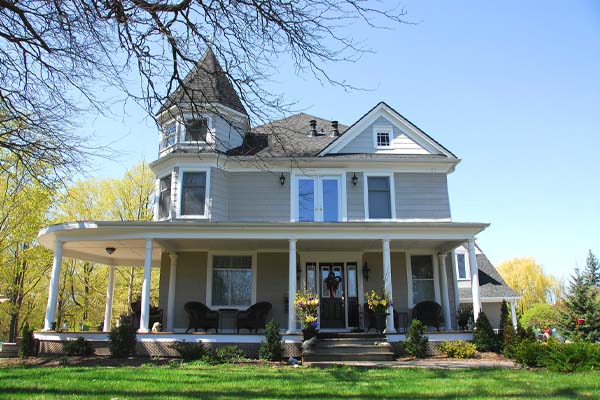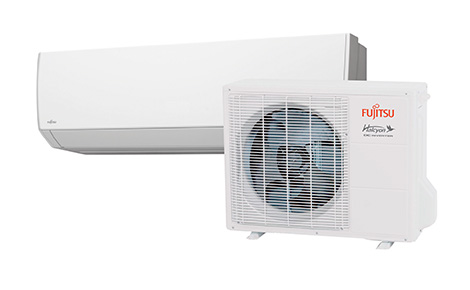
Historic homes typically do not have the type of structure that will accommodate most modern air conditioning designs. Many older homes are well-maintained, but the layout inherent to their design often makes it very challenging which type and size of the air conditioning system should be installed. Also, most historic homes do not have ductwork. Therefore, adding ductwork would require a major reconstruction project, impacting the aesthetic value of the home. There is also the issue regarding the reliability of the insulation that a historic home has. However, out of all of the HVAC systems available, ductless air conditioning is the most viable option. It enables you to preserve your historic home while ensuring it feels comfortable in an energy-efficient manner.
What Are Ductless Mini-Split Systems?
Ductless mini-split systems are a type of heating and cooling systems that provide temperature control in different rooms or areas of a home. The main components of a mini-split system are the indoor air handler or evaporator and the outdoor compressor or condenser. There is also a conduit that runs in between the indoor and outdoor unit. Depending on the size of the home and the needs of the occupants, there may be between one or more indoor air handling units to accommodate different zones or areas.
Advantages Of Ductless Air Conditioners
Ductless mini-splits are the preferred cooling solution for a historic home. They offer several advantages, such as:
Energy Efficiency
About 25% of energy is lost to ductwork, something that can be avoided with a ductless system. Also, window AC units tend to perform inefficiently and have high operating costs. Ductless models, on the other hand, have inverter-based compressors that can slow down or speed up depending on what it senses in the room or zone. Conventional HVAC compressors often have to shut down and start up again just to keep the system running. Since more energy is consumed when the compressor starts up, you save more in energy use with a ductless air conditioning system.
Furthermore, ductless units can be turned off when you leave the room. This way, you don’t have to pay to cool an empty room. This is also another great feature that central units don’t offer.
Indoor Air Quality
Improved multi-stage air filtration and the absence of ductwork ensures improved indoor air quality (IAQ) with ductless mini-splits. Dust, pollen, dander, and other tiny particles tend to accumulate in the ductwork. The HVAC system releases these indoor air pollutants into the rooms and spaces via the vents. Likewise, window air conditioning units tend to create the perfect environment for mold, bacteria, and mildew, impacting your IAQ. In ductless systems, this problem is eliminated.

Zoning
Ductless mini-splits allow the creation of zones – areas or rooms that can be grouped together based on temperature preferences. As such, each zone can have a different temperature setting. For example, you can set the kitchen and pantry at a lower temperature while you can set the bedrooms at a higher temperature. Since zones are independent of each other, people can maximize their enjoyment of indoor conditions without sacrificing their personal comfort.
Whisper-Quiet Operation
Ductless systems are the perfect fit for your historic home, especially if you prefer low-noise and whisper-quiet operation. Indoor units have small tubes through which it distributes conditioned air. Ducted systems, however, utilize large duct systems that generate high levels of noise. Window air conditioners are also notorious for being loud and noisy since the components are in one single unit. Also, there is no insulation, which further exacerbates the problem.

Ease Of Installation
HVAC technicians will tell you that ductless mini-splits are some of the easiest heating and cooling equipment to install. They do not require intensive work and whatever drilling takes place is down to a bare minimum. This aspect is very different than installing a central air conditioning system that requires the installation of ductwork, a major construction project in a home.
Environmentally Friendly
Ductless air conditioning systems do not use as much energy as conventional AC systems or window air conditioning units. The refrigerant required for AC systems is also an environmentally-friendly coolant. When you use a ductless AC for your historic home, you not only ensure the comfort of residents indoors but you also do not contribute to the pollution of the environment.
Reduced Home Heating And Cooling Costs
Energy-efficiency translates to lower costs. Of course, operating costs will vary depending on the size and model but since ductless ACs only cool rooms that are occupied and not the entire house, you pay less in terms of energy consumed. Also, they have high SEER ratings, some of the highest out of all the air conditioners on the market.

How Will Ductless Air Conditioning Affect The Structure Of A Historic Home?
The great thing about a ductless air conditioning system is that it does not require the installation of ductwork. If a homeowner decides to install a network of ducts, it will require extensive (and costly) construction work that will include tearing down walls and ceilings and rebuilding them again. A ductless system will only require a small, three-inch hole that an HVAC contractor drills through the wall to connect the indoor unit to the outdoor unit. If there is any damage at all that will be done to the home, it is this small hole. Ductless ACs are also compact in size and will not require too much space for installation.
Are Window ACs A Good Alternative To Ductless ACs?
Window ACs may seem like a close alternative to ductless systems, but window-type air conditioners are notorious for many reasons. They require a giant hole through the wall or at least, a space on a window. If they do occupy the wall or a window, they leave your historic home vulnerable to pests and burglars who could easily enter the house through the hole or window space. Window-type ACs also block natural light and will require removal and storage during winter. They also tend to be noisy and encourage the growth of mold and mildew, as mentioned above.
Conclusion
A historic home deserves to be preserved and maintained, so it retains its beauty and value. Although cooling a historic home can be challenging, it is not impossible, thanks to ductless air conditioning systems that are not only effective but also capable of maintaining the aesthetics of a home with a long history. If you want to know more about how a ductless mini-split system can help you keep your home cool, talk to your local HVAC company today.
Call Point Bay Fuel To Learn More About Ductless HVAC Systems
 Point Bay Fuel offers superior heating and cooling services in the area. We hire the best NATE certified technicians who can provide you with excellent HVAC tune-ups, repairs, installations, and replacements. Each of our techs has the knowledge and experience to service your HVAC system correctly.
Point Bay Fuel offers superior heating and cooling services in the area. We hire the best NATE certified technicians who can provide you with excellent HVAC tune-ups, repairs, installations, and replacements. Each of our techs has the knowledge and experience to service your HVAC system correctly.
Point Bay Fuel guarantees the most competitive heating and cooling service costs in the area. For HVAC repairs or installations, we can recommend the best solution for your home while staying within your budget. As always, we prioritize energy efficiency, comfort, indoor air quality, and more. To schedule an appointment, give Point Bay Fuel a call today for a free, in-home estimate.
Contact us now by calling (732) 349-5059 to speak to one of our home comfort specialists!
The post The Challenges Of Cooling Historic Homes appeared first on Point Bay Fuel.
No comments:
Post a Comment